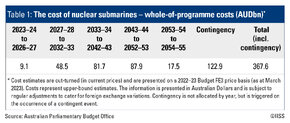What to spend $40B on?
Infrastructure, training and competitive salaries for all the additional trades, technical and engineering personnel it is so hard to recruit and retain.
In the US defence workers are among the highest paid and government defence workers higher than industry, well there's a model we can adopt.
Worried about unions? Easy, improve pay and conditions to the point that workers don't feel like they are being ripped off, i.e. trade qualified shipbuilders doing hot, dirty work in all sorts of weather being paid less than an assistant or junior insurance broker or clerk.
Recognise, for the first time since the structural changes to our economy during the successive mining booms and the end of large scale automotive manufacturing, that people who make things, especially those who do the skilled physical work on mega projects, are worth more to the economy than clerks, sales people, admin people with our without an MBA.
This will save us money on major defence projects in the long run, easily to the point that we could build one or two extra ships for the same batch price.
Realigning wages will encourage people back into trades and engineering, especially if there are apprenticeships and cadetships paying decent wages to get the qualification, then a decent pay jump upon qualification to get them to stay.
Once the infrastructure and workforce is in place productivity improvements will improve value for money, reduce unit costs and permit the government to build more for a given budget.
Older equipment can be replaced with new instead of poor value for money major upgrades and life extensions. This increased scale and frequency of production will again improve efficiency.
Regular introduction of new equipment will increase lethality and capability.
Selling still good older stuff will make long-term, end of life disposal someone else's problem, put money back in the kitty, and increase the capabilities of the nations we sell to.
New equipment is easier to maintain, has less down time for maintenance and upgrade and, in general a lower in-service support profile, therefore requiring fewer in-service support personnel.

